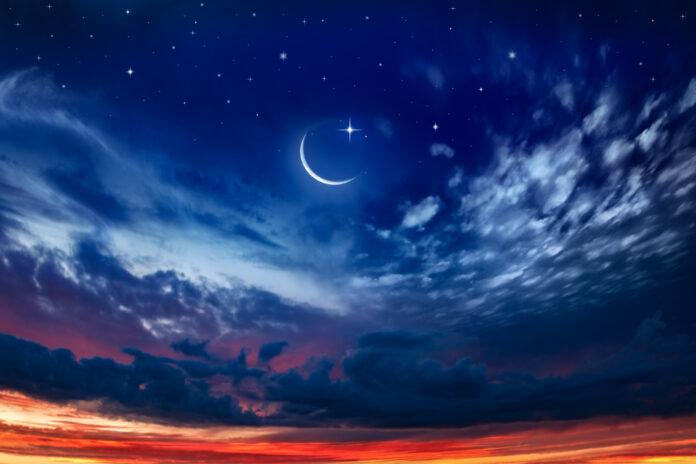For the first time the British government has issued guidance on the date of Eid, and has concluded that it cannot be before next Saturday.
Its guidance states that for new moon sighters in the Middle East, North Africa and the United Kingdom, easy sightings of the crescent moon should be possible with the naked eye on Friday April 21st, Saturday April 22nd, and Sunday April 23rd.
According to the government, the actual arrival of the new Moon takes place on Thursday but sightings with telescopes will only be possible from north-eastern Canada and northern parts of South America.
Naked-eye sightings under excellent conditions on the same day will be possible from the northern Caribbean region, Central America and southern and western parts of North America. Easy sightings will also be possible from northern Polynesia, including the Hawaiian Islands.
But on Friday April 21st the overwhelming majority of the globe should be able to make easy sightings of the crescent moon with one or two very small exceptions in the southern hemisphere.
Naked-eye sightings are likely almost globally on Friday April 21st, Saturday April 22nd and Sunday April 23rd.
Here is the government’s detailed breakdown of the arrival of the new moon:
Subscribe to our newsletter and stay updated on the latest news and updates from around the Muslim world!
Thursday April 20th, 2023
A telescopic sighting of the crescent moon with small, conventional amateur-sized telescopes is possible from the central Atlantic Ocean region including the Azores, north-easternmost parts of Canada and northern parts of South America.
Optical aids may be needed to find the crescent moon from the southern Caribbean region, north-eastern parts of North America, north western parts of South America and southern Polynesia.
Naked-eye sightings under excellent conditions are possible from the northern Caribbean region, Central America and southern and western parts of North America. Easy sightings are possible from northern Polynesia including the Hawaiian Islands and some of the Aleutian Islands.
Friday April 21st, 2023
A telescopic sighting of the crescent moon with small, conventional amateur-sized telescopes will be possible from northern New Zealand and south-easternmost parts of Australia.
Optical aids may be needed to find the crescent moon from south-eastern Australia and southernmost parts of South America.
Naked-eye sightings under excellent conditions are possible from central parts of Australia and southernmost parts of South America.
The rest of the world should be able to make easy sightings of the crescent moon. Easy sightings with the naked eye should be possible from the Middle East, North Africa and the United Kingdom in particular.
Saturday April 22nd, 2023
The crescent moon should be easily visible on a global basis with the possible exception of Antarctica. Easy sightings with the naked eye should be possible from the Middle East, North Africa and the United Kingdom in particular.
Moon sighting controversy
The controversy over the date of Eid is related to the fact that the Islamic calendar is based on the lunar cycle, which is about 29.5 days long. This means that each month in the Islamic calendar begins with the sighting of a new crescent moon.
The problem arises because different regions and countries rely on different methods for determining the start of the lunar month. Some rely on actual sightings of the crescent moon, while others use astronomical calculations or rely on official announcements from religious authorities.
This can lead to differences in the date of Eid between different regions and countries, sometimes by as much as a day or two. Additionally, there are some differences of opinion among Islamic scholars about the proper way to determine the start of the lunar month, which can also contribute to the controversy over the date of Eid.























